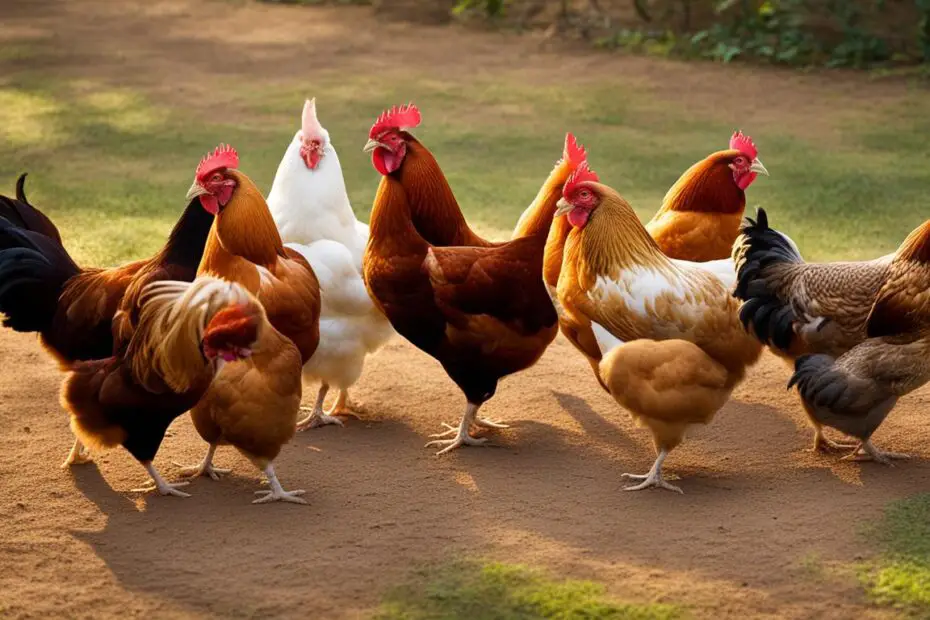In this comprehensive guide, we will explore everything you need to know about the Brahma chicken color chart. From understanding the different color variations and genetics to patterns and standards, we have gathered information from reliable sources to provide you with an in-depth understanding of Brahma chicken colors.
Key Takeaways:
- Brahma chickens come in a variety of colors and patterns, making them visually stunning.
- Understanding the genetics behind Brahma chicken colors is essential for successful breeding.
- The Brahma chicken color chart provides guidelines and standards for breeders and enthusiasts.
- There are variations in color patterns, such as light, buff, and dark Brahma chickens.
- By exploring the Brahma chicken color chart, you can select the colors and characteristics that appeal to you.
What are the Three Recognized Brahma Chicken Color Varieties?
The American Poultry Association recognizes three official Brahma chicken color varieties: Light Brahma, Buff Brahma, and Dark Brahma. Each variety has distinct color patterns and characteristics.
Light Brahma
The Light Brahma variety is primarily white with black feather details on the neck and tail. They have a stunning contrast between the white body and the dark feathering. Light Brahmas are known for their calm and friendly temperament, making them a popular choice for backyard flocks.
Buff Brahma
The Buff Brahma variety has a beautiful caramel-colored plumage with black detailing on the neck and tail. They have a warm and inviting appearance, with a gentle and docile nature. Buff Brahmas are admired for their striking color and easygoing temperament, making them a favorite among chicken enthusiasts.
Dark Brahma
The Dark Brahma variety features exquisite penciling on the feathers, with grey body feathers and black lacing on the neck. They have a majestic and regal appearance, with a confident and calm demeanor. Dark Brahmas are known for their striking beauty and make an impressive addition to any chicken flock.
Each of these three Brahma chicken color varieties offers unique characteristics and stunning colors. Whether you prefer the elegant white and black of the Light Brahma, the warm caramel tones of the Buff Brahma, or the striking grey and black patterns of the Dark Brahma, these varieties are sure to add beauty and charm to any flock.
The Appearance of Brahma Chickens
Brahma chickens are truly remarkable in their appearance. They are known for their large size and impressive stature. Standing at an average height of 18 inches, these birds command attention with their broad and stocky bodies. The hens typically weigh around 8 pounds, while the roosters can reach up to 10 pounds. Their considerable size and weight make them one of the largest chicken breeds in existence.
When it comes to their physical features, Brahma chickens have small heads with prominent eyes and short beaks. These characteristics give them a distinct look that sets them apart from other breeds. Additionally, they have pea combs, which are small and rounded combs on top of their heads. These combs are unique to Brahma chickens and further contribute to their overall appearance.
The most striking aspect of Brahma chickens is undoubtedly their dense feathering. Their feathers are abundant and thick, providing both insulation and protection. The feathers usually have intricate patterns and detailing, adding to the allure of these magnificent birds. Whether it’s the soft white plumage of the Light Brahma or the caramel-colored feathers of the Buff Brahma, each variety showcases its own distinct beauty.
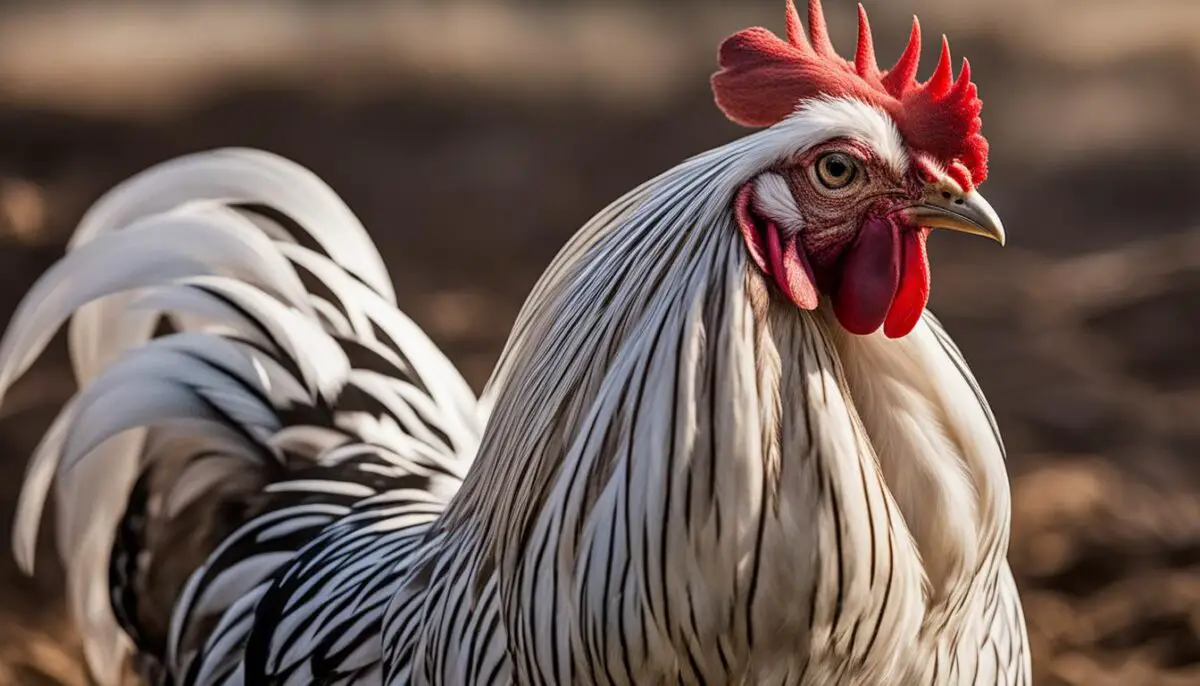
Overall, Brahma chickens are a sight to behold. With their large size, unique physical characteristics, and beautiful feathers, they are truly a remarkable breed that captures the attention of chicken enthusiasts and admirers alike.
The History of Brahma Chickens
Brahma chickens have a fascinating history that dates back to the mid-1800s in the United States. The breed was developed through a crossbreeding process that involved Shanghai Fowl from China and Chittagong Fowl from India. The result was a remarkable chicken breed known for its unique size and appearance.
The popularity of Brahma chickens soared when Queen Victoria of England received a gift of these chickens. Her interest in the breed helped spread awareness and popularity of Brahma chickens. Eventually, the breed made its way back to the United States and was officially recognized by the American Poultry Association in 1874.
Today, Brahma chickens are cherished for their rich history and distinctive characteristics. Whether you’re a chicken enthusiast or simply curious about the origins of this remarkable breed, understanding the history of Brahma chickens adds depth and appreciation to their presence in the poultry world.
Brahma Chickens for Sale
If you’re interested in owning Brahma chickens, you can find them for sale at various hatcheries across the United States. While there is no specific hatchery that specializes in Brahma chickens, they are relatively common and can be found online. Prices for Brahma chickens have come down significantly since their peak popularity, with chicks typically ranging from $3 to $10 each. Before purchasing, consider the space requirements and care needs of Brahma chickens.
Brahma chickens require ample space due to their large size. They need a coop that provides at least 4 square feet of floor space per bird. It’s important to ensure they have enough room to move around freely and exhibit their natural behaviors. Additionally, Brahma chickens thrive in a free-range environment where they can roam and forage.
When purchasing Brahma chickens, it’s advisable to buy from reputable hatcheries that prioritize the health and well-being of their birds. Look for hatcheries that have a good reputation and have proper biosecurity protocols in place. This will help minimize the risk of bringing home birds with potential diseases or health issues.
| Hatchery | Location | Price (per chick) |
|---|---|---|
| ABC Hatchery | California | $5 |
| XYZ Hatchery | Texas | $4 |
| 123 Hatchery | Ohio | $3 |
These are just a few examples of hatcheries that offer Brahma chickens for sale. Prices and availability may vary, so it’s best to check with multiple hatcheries and compare options before making a purchase. Remember to consider the shipping costs if buying online, as well as any additional requirements for minimum order quantities.
Brahma Chicken Egg Laying
Brahma hens are known for their medium-to-large egg laying capabilities. On average, they lay about 3 to 4 eggs per week, which adds up to approximately 150 eggs per year. These hens may not be the most prolific layers, but they still contribute a steady supply of eggs to your flock.
The eggs laid by Brahma chickens are caramel brown in color, adding visual appeal to your egg collection. They have an average size of around 2 ounces or 56 grams, making them larger than the average chicken egg. With their unique color and size, Brahma chicken eggs can be a delightful addition to your breakfast table or culinary creations.
Despite their size and reduced egg production compared to other breeds, a small backyard flock of Brahma hens can still provide a dozen eggs per week. Their consistent laying throughout the year ensures a steady supply of delicious eggs for your family.
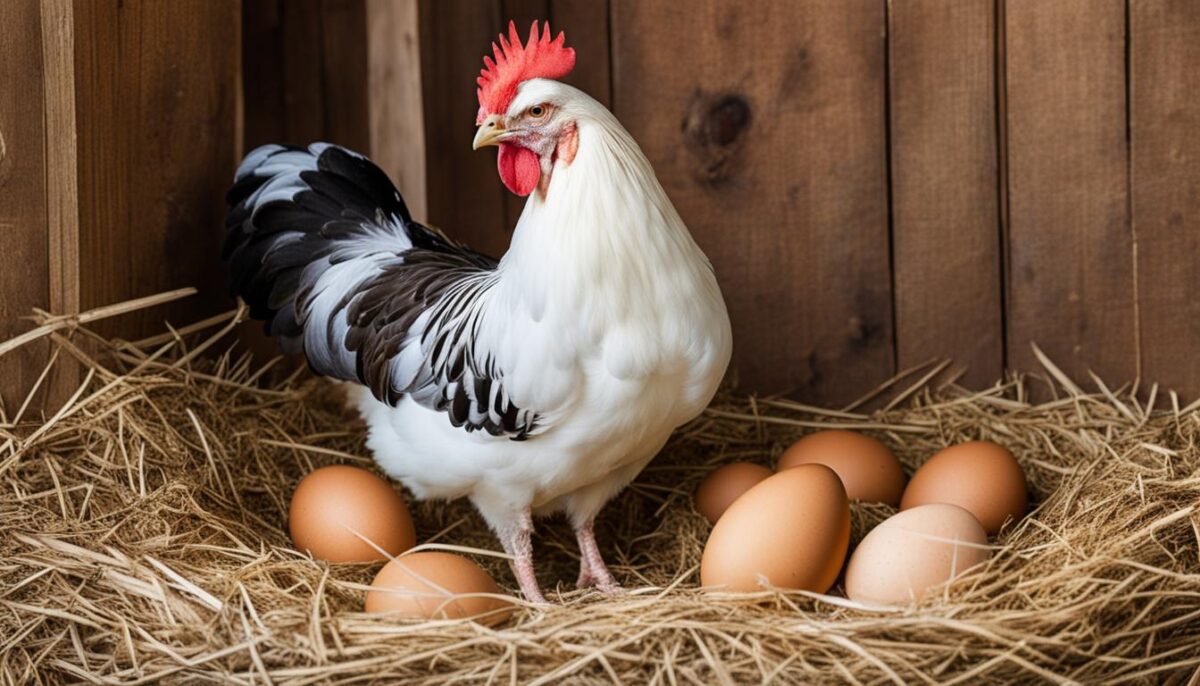
| Average Egg Laying | Annual Egg Production | Egg Size | |
|---|---|---|---|
| Brahma Hens | 3-4 eggs per week | Approximately 150 eggs | 2 ounces or 56 grams |
In summary, Brahma chickens may not lay eggs as frequently as some other breeds, but their medium-to-large-sized eggs make them a valuable addition to any backyard flock. Their caramel brown color adds an aesthetic touch to your egg collection, and their consistent laying throughout the year ensures a steady supply. Whether you’re a homesteader or an egg enthusiast, Brahma hens can provide you with eggs that not only taste great but also bring visual appeal to your kitchen.
Brahma Chicken Health and Care
Ensuring the health and well-being of your Brahma chickens is essential for their longevity and happiness. By providing proper care and attention, you can minimize the risk of common health issues and create a safe and comfortable environment for your flock.
Health Considerations
- Brahma chickens are generally hardy and adaptable; however, they can be susceptible to certain health issues. Regularly monitoring your chickens and understanding the signs of common diseases is crucial for early detection and treatment.
- Bumblefoot is a common condition in chickens, including Brahmas. It is caused by bacteria entering through small cuts or scrapes on their feet. Regularly inspect the feet, keep the coop clean, and provide a comfortable substrate to prevent this condition.
- Parasites like lice and mites can also affect Brahma chickens. Inspect regularly for signs of infestation, such as feather loss, irritation, or visible pests. Treatments are available to eliminate these parasites if necessary.
Care and Maintenance
Creating a suitable living environment is crucial for the health and well-being of your Brahma chickens. Here are some important considerations:
- Coop Size and Ventilation: Provide ample space for your chickens to roam and dustbathe. A well-ventilated coop with proper insulation is essential for their comfort.
- Nutrition: Ensure your Brahma chickens have access to a balanced diet. Commercial poultry feeds, supplemented with fresh fruits, vegetables, and occasional treats, will provide the necessary nutrients for their overall health.
- Water: Clean and fresh water should be available at all times. Ensure the water containers are kept clean and free from debris.
- Bedding and Cleaning: Use suitable bedding material in the coop, such as straw or wood shavings, and clean it regularly to prevent the buildup of waste and parasites.
By following these care guidelines and maintaining a clean and well-managed environment, you can help ensure the health and happiness of your Brahma chickens.
Brahma Chicken Temperament
Brahma chickens are beloved for their friendly and docile temperament, making them an excellent choice for both beginners and experienced flock owners. They are often referred to as the “gentle giants” of the chicken world because of their large size and calm demeanor.
These majestic birds are known for their easygoing nature and are generally easy to handle. They are not aggressive and can coexist peacefully with other chickens, making them suitable for mixed-breed flocks. Additionally, Brahma roosters are typically non-aggressive and do not display territorial behavior.
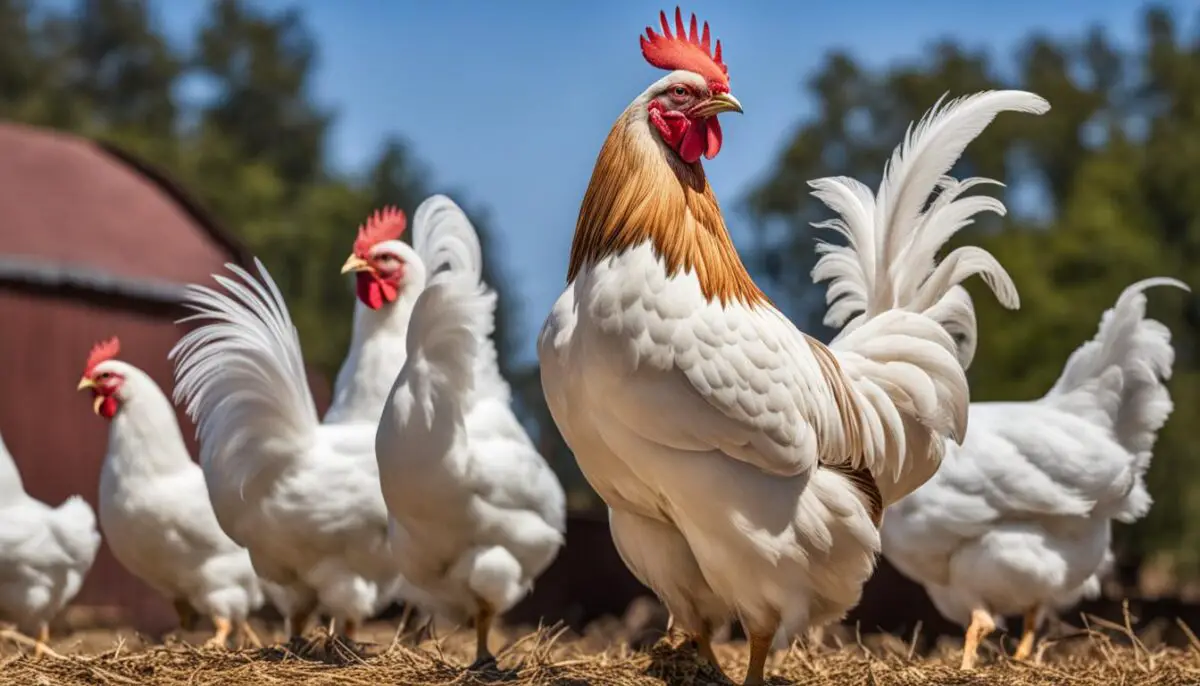
Brahma chickens are also known to be friendly towards people, including children, and are often described as gentle and tolerant. Their laid-back disposition makes them a popular choice for families with children or pets. Whether you have a backyard flock or live in a rural setting, Brahma chickens can bring joy and entertainment to your daily life.
In summary, Brahma chickens are known for their friendly and peaceful temperament. Their calm and docile nature, combined with their impressive size, make them a delightful addition to any flock. Whether you’re a beginner or an experienced chicken owner, you’ll find that Brahma chickens are a pleasure to interact with and care for.
Breeding and Genetics of Brahma Chicken Colors
Breeding and genetics play a crucial role in determining the color variations and patterns of Brahma chickens. Breeders carefully select and cross different color varieties to achieve specific color combinations and enhance the quality of Brahma chicken colors. Understanding the genetics of color inheritance is essential for successful breeding and maintaining the distinct characteristics of each variety.
One important aspect of Brahma chicken color genetics is the presence of specific genes that influence coloration. For example, the Andalusian Blue gene is responsible for the striking blue color seen in certain Brahma chickens. Breeders carefully select birds with the desired color genes and use them in breeding programs to produce offspring with consistent color patterns.
To create a visually engaging table, we can compare the color genetics of different Brahma chicken varieties:
| Brahma Chicken Variety | Main Color Gene | Other Genes |
|---|---|---|
| Light Brahma | Gold | Silver, Blue |
| Buff Brahma | Gold | Silver, Blue |
| Dark Brahma | Gold | Silver, Blue |
It’s important to note that breeding for color can be a complex process, as multiple genes interact to produce the final color phenotype. Breeders often keep detailed records of their breeding programs and track the color genetics of their breeding stock to achieve consistent and desirable color patterns in their Brahma chickens.
Pros and Cons of Brahma Chickens
Brahma chickens offer unique advantages and considerations for aspiring poultry enthusiasts. Let’s take a look at the pros and cons of keeping these magnificent birds in your flock.
Pros of Brahma Chickens:
- Large Size: Brahma chickens are renowned for their impressive size, making them an eye-catching addition to any backyard flock.
- Colorful and Unique Patterns: With their distinct color variations and intricate feather patterns, Brahma chickens are a delight to behold.
- Friendly Temperament: Brahma chickens are known for their docile and friendly nature, making them suitable for families and enjoyable to interact with.
- Good with Other Animals: These gentle giants generally get along well with other chickens, pets, and even children, making them a great choice for a diverse backyard flock.
- Egg Production: While not the most prolific layers, Brahma hens still provide a steady supply of medium-to-large caramel-brown eggs throughout the year.
Cons of Brahma Chickens:
- Space Requirements: Due to their larger size, Brahma chickens need more space compared to regular chicken breeds, requiring adequate room to roam and stretch their legs.
- Potential Health Issues: Like any breed, Brahma chickens can be prone to certain health concerns such as bumblefoot, lice, and mites. Regular monitoring and proper care are necessary to ensure their well-being.
- Higher Costs of Care: Brahma chickens may require slightly higher costs of care compared to standard chicken breeds due to their size, dietary needs, and potential health issues.
By carefully considering these pros and cons, you can make an informed decision about whether Brahma chickens are the right addition to your flock. They offer beauty, friendly personalities, and unique characteristics, but it’s essential to ensure you can provide the necessary space, care, and resources they require.
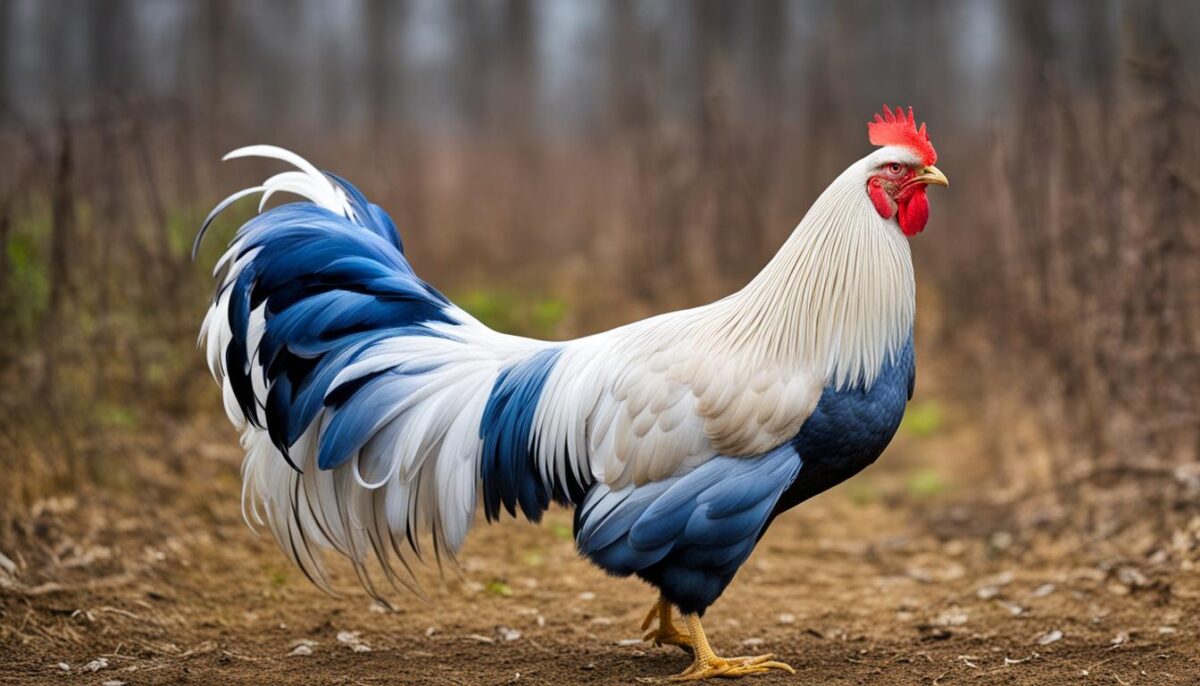
Conclusion
In conclusion, the Brahma chicken color chart offers a stunning variety of colors and patterns. Understanding the different varieties, their appearances, history, temperament, and breeding is essential for Brahma chicken enthusiasts. Whether you’re interested in raising them for their beauty, friendly nature, or egg production, Brahma chickens can make a delightful addition to your flock.
Take time to research and select the colors and characteristics that appeal to you, and enjoy the wonderful world of Brahma chicken colors.
By exploring the Brahma chicken color chart, you can create a visually appealing and diverse flock of chickens. From the classic white and black patterns of the Light Brahma to the caramel-colored plumage of the Buff Brahma, there are various options to choose from. Understanding the origins, size, and temperament of Brahma chickens can help you make an informed decision when adding them to your flock.
Whether you’re a beginner or an experienced chicken owner, the Brahma chicken color chart provides a valuable resource for selecting and breeding these magnificent birds. With their friendly temperament and exceptional beauty, Brahma chickens are sure to be a source of joy and fascination for any poultry enthusiast.
FAQ
What are the three recognized Brahma chicken color varieties?
The three recognized Brahma chicken color varieties are Light Brahma, Buff Brahma, and Dark Brahma.
What is the appearance of Brahma chickens?
Brahma chickens have broad, stocky bodies with dense feathering. They have small heads, prominent eyes, short beaks, and pea combs. Their feathers are dense and usually feature intricate patterns and detailing.
What is the history of Brahma chickens?
Brahma chickens originated in the United States during the mid-1800s through crossbreeding Shanghai Fowl from China with Chittagong Fowl from India. They were popularized by Queen Victoria of England and were eventually accepted into the American Poultry Association’s Standard of Perfection in 1874.
Where can I find Brahma chickens for sale?
Brahma chickens can be found for sale at various hatcheries across the United States. They are relatively common and can be found online.
How many eggs do Brahma chickens lay?
Brahma hens lay medium-to-large eggs, averaging 3 to 4 eggs per week. This amounts to approximately 150 eggs per year. The eggs are caramel brown in color and Brahma hens are known to lay throughout the year.
What are the common health concerns for Brahma chickens?
Some common health concerns for Brahma chickens include bumblefoot, lice, and mites. Regular vaccination, coop cleaning, and monitoring can help prevent these issues.
What is the temperament of Brahma chickens?
Brahma chickens are known for their friendly and docile temperament. They are calm, easy to handle, and do well in mixed-breed flocks. They are friendly towards people, children, and other pets.
What is the breeding and genetics of Brahma chicken colors?
Breeders focus on maintaining and improving the distinct color patterns of each Brahma chicken variety. Understanding the inheritance of color genes is essential for successful breeding. Breeders often cross different color varieties to achieve specific color combinations and patterns.
What are the pros and cons of Brahma chickens?
The pros of Brahma chickens include their friendly temperament, large size, and unique color patterns. They are great for families and backyard flocks. The cons include the need for more space, potential health issues, and higher costs of care compared to regular chickens.


